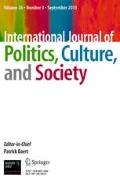Abstract
Using the case of the Holocaust as a cultural trauma in the Jewish-Israeli context, some insights are suggested as to the ways younger members of collectives view cultural trauma as a symbolic boundary. The findings obtained from three groups of students, each expressing their views on a different facet of the Holocaust as a symbolic boundary, suggest that the major contributing factor that turns cultural trauma into a symbolic boundary is the way in which members of the collective categorize the modes through which others, within and outside the collective, relate to that cultural trauma.
Similar content being viewed by others
Notes
See for example Jerusalem Post, May 5, 2006; Jerusalem Post, September 10, 2007; and Ha’Aretz, November 3, 2007.
References
Alexander, J. C. (2004). Toward a theory of cultural trauma. In J. C. Alexander, R. Eyerman, B. Giesen, N. J. Smelser & P. Sztompka (Eds.), Cultural trauma and collective identity (pp. 1–30). Berkeley, CA: University of California Press.
Blumner, N. (2006). The Holocaust as stark reminder: Ethno-national identity, Diaspora and the ideological process(es) of Memory. Paper presented at the annual meeting of the American Sociological Association, Montreal Convention Center, Montreal, Quebec, Canada, Aug. 10, 2006.
Brug, M. (1996). From the top of Masada to the heart of the ghetto: Myth as history. In D. Ohana & R. S. Wistrich (Eds.), Myth and memory: Transfiguration of Israeli consciousness (pp. 203–227). Jerusalem: Van Lear Institute and HaKibutz HaMeuchad. (in Hebrew).
Cohen, E. H. (2004). Components and symbols of ethnic identity: A case study in informal education and identity formation in Diaspora. Applied Psychology: An International Review, 53(1), 87–112.
Edmunds, J., & Turner, B. S. (2005). Global generations: Social change in the twentieth century. The British Journal of Sociology, 56(4), 559–577.
Epstein, C. F. (1992). Tinker-bells and pinup: The construction and reconstruction of gender boundaries at work. In M. Lamont & M. Founrnier (Eds.), Boundaries and the making of inequality (pp. 232–256). Chicago: University of Chicago Press.
Fuller, S. (2003). Creating and contesting boundaries: Exploring the dynamics of conflict and classification. Sociological Forum, 18(1), 3–30.
Half, L. M., Singer, J. A., & Mackinnon, J. R. (1999). Jewish identity, hostility toward Germany, and knowledge about the Holocaust in the United States and Germany. Journal of Psychology and Judaism, 23(3), 107–124.
Kurtz, L. R. (1983). The politics of heresy. American Journal of Sociology, 88(6), 1085–1115.
Lamont, M., & Molnár, V. (2002). The study of boundaries in the social sciences. Annual Review of Sociology, 28, 167–195.
Lazar, A., Litvak-Hirsch, T., & Chaitin, J. (2008). Between culture and family: Jewish-Israeli young adults relation to the Holocaust as a cultural trauma. Traumatology, 14(4), 93–102. doi:10.1177/1534765608321071.
Lessl, T. M. (1988). Heresy, orthodoxy, and the politics of science. Quarterly Journal of Speech, 74, 18–34.
Levy, D., & Sznaider, N. (2005). The Holocaust and memory in the global age. Philadelphia: Temple University.
Mayring, P. (2000). Qualitative content analysis. Forum Qualitative Sozialforschung/Forum: Qualitative Social Research, 1(2) (online journal). http://www.qualitative-research.net/fqs-texte/2-00/2-00mayring-e.htm. Accessed 28 November 2007.
Smelser, N. J. (2004). Psychological trauma and cultural trauma. In J. C. Alexander, R. Eyerman, B. Giesen, N. J. Smelser & P. Sztompka (Eds.), Cultural trauma and collective identity (pp. 31–59). Berkeley, CA: University of California Press.
Stamm, B. H., Stamm, H. E., Hudnall, A. C., & Higson- Smith, C. (2003). Considering a theory of cultural trauma and loss. Journal of Trauma and Loss, 9(1), 89–111.
Volkan, V. D. (2001). Transgenerational transmissions and chosen traumas: An aspect of large-group identity. Group Analysis, 34(1), 79–97.
Vopel, S. (2007). Germen-Jewish dialog—A survey in Germany. Israel: Bretelsmann Stiftung, Güterloh.
Werbner, P. (2002). The place which is Diaspora: Citizenship, religion and gender in the making of chaordic transnationalism. Journal of Ethnic and Migration Studies, 28(1), 119–133.
Author information
Authors and Affiliations
Corresponding author
Rights and permissions
About this article
Cite this article
Lazar, A., Litvak-Hirsch, T. Cultural Trauma as a Potential Symbolic Boundary. Int J Polit Cult Soc 22, 183–190 (2009). https://doi.org/10.1007/s10767-009-9060-1
Published:
Issue Date:
DOI: https://doi.org/10.1007/s10767-009-9060-1



